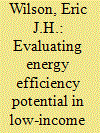| Srl | Item |
| 1 |
ID:
166459


|
|
|
|
|
| Summary/Abstract |
This study presents a new approach to evaluating energy efficiency potential that provides a more accurate, granular, and flexible estimate of the cost-effective energy efficiency potential in households of various income ranges.
Results from this work estimate that in U.S. single-family households with income less than 200% of the federal poverty level, energy efficiency packages tailored to maximize net present value could result in an estimated $13 billion per year in energy cost savings, or $670 per year for an average household, corresponding to about 1 EJ (0.9 quads) of annual primary energy savings. These types of metrics can be estimated for other geographies (regions, states, and counties) and for other ranges of household income.
|
|
|
|
|
|
|
|
|
|
|
|
|
|
|
|
| 2 |
ID:
179750


|
|
|
|
|
| Summary/Abstract |
The implementation of energy efficiency measures (EEMs) is the primary means of improving industrial energy efficiency (IEE). Almost 69% of industrial electricity use emanates from motor systems. IEE has traditionally been explained with technology-diffusion models. According to these models, increased diffusion of more effective motors and drives onto the market leads to improved efficiency. Electric motor systems are represented by three levels: electric motor, core motor system, and total motor system. The first and second levels are related to stand-alone technology measures while the third has a more operational character. Based on a unique dataset of implemented energy-efficiency motor system measures from the 100 most electricity-intensive industrial companies in Sweden, the aim of this paper is to study whether technology diffusion is a valid model for understanding improved energy efficiency in electricity-intensive industries. Results show that 59% of the implemented EEMs from the dataset go beyond technology diffusion models, implying a need for revised models to understand how energy efficiency and technology diffusion occur in energy-intensive industry.
|
|
|
|
|
|
|
|
|
|
|
|
|
|
|
|